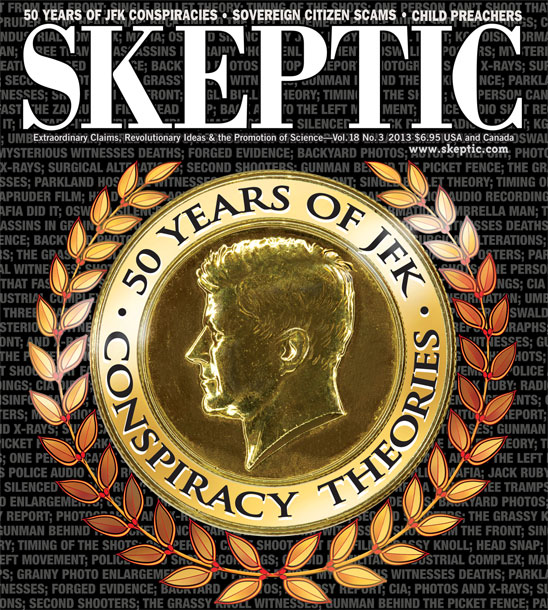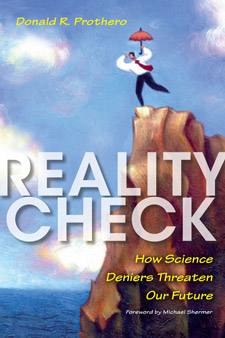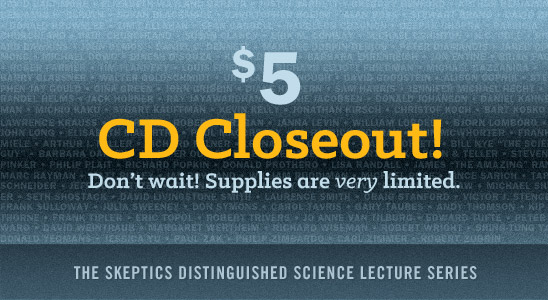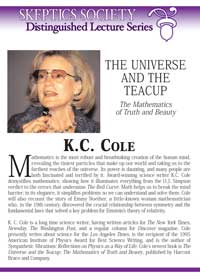In this week’s eSkeptic:
Skeptic magazine 18.3
50 Years of JFK Conspiracy Theories
The latest issue is available now in print and digital formats. Order a hard copy or download the digital version using the Skeptic Magazine App for iOS, Android, BlackBerry PlayBook, Kindle Fire HD, Mac, PC, and Windows 8 devices. This issue won’t likely hit newsstands for another week or two and current subscribers should receive it by the end of September.

Reality Check
SKEPTICALITY EPISODE 214
This week on Skepticality, Derek presents another interview conducted at The Amazing Meeting 2013. In Las Vegas, he sat down with Dr. Donald Prothero to discuss another of his books which was recently released, Reality Check: How Science Deniers Threaten Our Future. Find out why Dr. Prothero has dedicated so much of his time attempting to ensure the public becomes more scientifically literate, and what he fears will happen if they don’t.
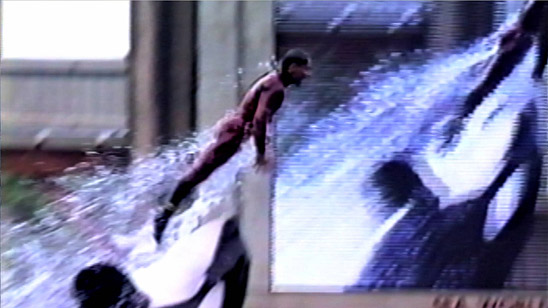
About this week’s eSkeptic
In this week’s eSkeptic, Donald R. Prothero reviews Gabriela Cowperthwaite’s film Blackfish (Magnolia Pictures, 2013), about Tilikum — a killer whale in captivity at SeaWorld responsible for the deaths of several people. Read Prothero’s full bio after the article.
Free Tilly!
by Donald R. Prothero
Every year, millions of people visit marine theme parks, especially those run by the giant SeaWorld Corporation, including three in the U.S. in San Diego, San Antonio, and Orlando. They spend hundreds of millions of dollars not only in admissions and rides, but also food, merchandise, parking and many other expenses. My own family used to have an annual pass to SeaWorld San Diego, because we visited so frequently. The centerpiece of each visit was the killer whale (or orca) show, where “Shamu” (a role played by many different whales) goes through its tricks, splashes the audience, and astonishes us with its apparent “tameness” despite their scary size. But after watching Blackfish, I can no longer stand to go there. I cannot imagine watching the killer whale show ever again.
Blackfish is a gripping documentary film that follows a series of recent events concerning the abuse of orcas in captivity, especially as they have long been used in shows. First released at the Sundance Film Festival in January 2013, since July it has gone into wider release in large cities with movie houses that specialize in indie, foreign, and documentary films. It has received universal rave reviews, and rated a 98% “Fresh” ranking on the RottenTomatoes.com movie site. Unlike some exposés, this movie (“blackfish” is the name that First Nations people gave to orcas) obtained an incredible amount of information and access, and interviews nearly all the people close to the story (including a number of former SeaWorld trainers who quit when they could no longer live with themselves). Through the details provided by these many trainers and other witnesses, the film shows in gut-wrenching and painful detail how inhumane it is to keep a huge marine predator that is adapted to large complex social groups, and capable of swimming in packs hundreds of miles each day, and confining them for decades among other hostile whales in something that feels like a bathtub.
The movie begins with a teaser about the tragic death of senior SeaWorld trainer Dawn Brancheau on February 24, 2010, when she was performing with a 12,000-pound, 23-foot-long bull orca named Tilikum (“Tilly” to the trainers). It then jumps back in time to 1983, interviewing the man who captured Tilikum by tearing him away from his mother as a young calf in Iceland, killing many other whales in the pod, and covering up the crime. The film then traces Tilikum’s history: first, in a poorly run facility called SeaLand in Victoria, B.C. where he was brutalized by the older whales, confined to a very small pool, and eventually killed a trainer. When that incident caused SeaLand to close in 1992, Tilikum was sold to SeaWorld, where he became the star of the Orlando park. None of the staff knew of Tilikum’s traumatized past or his previous killing, and he became a regular in more and more shows as trainers took greater and greater risks. Yet the film documents many close calls where trainers nearly died, but the incidents were all covered up. In 1999, Tilikum killed a man who had hid after park closing, and apparently tried to get too close to the whale during the night (he was allegedly not detected, even though they have security cameras everywhere). His body was found naked and maimed, floating atop Tilikum, the next morning.
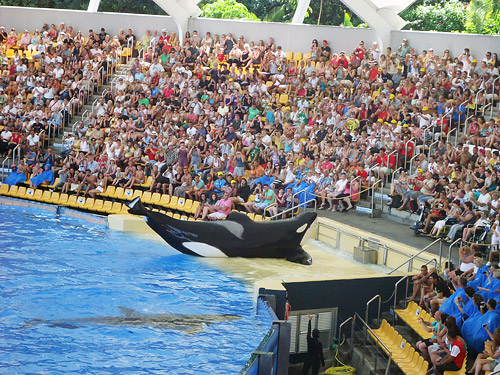
Still from the documentary Blackfish
Interspersed with the story of Tilikum are interesting interviews with marine biologists about orcas in the wild, describing their incredibly complex social structure, with a wide range of vocalizations that can be rightfully called “different languages.” Again and again, the movie demonstrates not only how intelligent these creatures are, but also how they are tightly bonded to their family units in the pod. The offspring never leave their mothers for their entire lives—unless death or a marine park separates them. Although SeaWorld is the primary focus of the story, the film takes a brief tour to another similar park in the Canary Islands west of Spain, where a marine park abused its animals, and eventually an orca killed a trainer. The film then concludes with the details of the death of Dawn Brancheau, and shows that Tilikum without provocation suddenly dragged her to her death, and then ate her. (You see a lot of gut-wrenching footage, but no actual killings or maimings).
This incident led to an OSHA investigation, with SeaWorld trying to escape liability by blaming it on “trainer error”, even though the video footage of the incident, the eyewitnesses, and the trainers who knew her, clearly demonstrate that she did nothing wrong. OSHA ruled against SeaWorld, and concluded that orcas were too dangerous to be handled this way. SeaWorld employees now must keep barriers between themselves and the whales at all times, and no longer enter the water with them. But there is a much larger issue here. At one time, we thought of orcas as frightening, terrible “killer whales” and they were the subject of numerous low-budget exploitation films. Now we understand that they are as intelligent, or more intelligent, than any other wild animal, with complex social behaviors and tight mother-offspring bonds—yet we treat them as “dumb fish” to be cooped up in tiny pools, and moved around from park to park, disrupting their family bonds that are seldom broken in the wild.
Clearly, it makes no sense to put humans in harm’s way, because these creatures are always “wild animals” that could turn on you and kill you in a few seconds. (Just ask Siegfried and Roy). But the film makes it clear that keeping them in these inhumane conditions is incredibly cruel and traumatic for them, and there is no real justification for it. They are not threatened in the wild, so (unlike some endangered animals in zoos) the marine parks are not protecting them from extinction. Nor does the “educational value” of letting a few people see them close-up justify the inhumanity of their confinement for decades. Some would argue that SeaWorld could build them bigger pools to swim in, although this is ludicrous when you realize they swim hundreds of miles a day in the wild. And what has SeaWorld been building instead? Roller coasters!
So why does SeaWorld do it, and why did they try to blame the victim whenever tragedy occurs? As you might expect, it’s all about money. Not only are the orca shows the biggest draws in SeaWorld (generating revenue not only with their shows, but especially with all the merchandise), but Tilikum in particular is valuable as a stud. His sperm is worth thousands of dollars, and consequently he is the father of a large number of the whales currently in the collections. (We even get to see how they stimulate the semen out of a bull orca in graphic detail). Clearly, SeaWorld views the orca show as critical to their entire business model. No wonder they refused to cooperate with the filmmakers. When they did respond to the film shortly before its release, their PR statement mostly misrepresented what the film actually says, or repeated the false claim that Dawn Brancheau was to blame for having a ponytail that the whale could grab (clearly debunked by the actual video footage). Corporations clearly want to protect themselves, but you emerge from the film disgusted with SeaWorld’s well-documented pattern of covering up dozens of dangerous incidents and close calls, and trying to play down or cover up the deaths that Tilikum alone caused—or blame the victim after she is dead and cannot defend herself.
The ancient Romans enjoyed brutality, watching gladiators fight to death in their arenas, and lions eat Christians. Animals of every kind were forced to fight and kill each other—all for entertainment. A few centuries ago, bear baiting was considered fun and acceptable as a sport. Bull fighting, dog fighting, and cock fighting are still found around the world, although they are illegal in most of the developed countries. We look on these practices and cannot imagine how people could derive enjoyment out of such horrendous treatment of animals. Perhaps some day soon, we’ll look back and have the same attitude toward depriving and torturing orcas, and keeping them in prison for our own enjoyment as well. After all, most research on chimps is over or nearly phased out. Sometimes we do make progress. ![]()
About the Author

DR. DONALD R. PROTHERO was Professor of Geology at Occidental College in Los Angeles, and Lecturer in Geobiology at the California Institute of Technology in Pasadena. He earned M.A., M.Phil., and Ph.D. degrees in geological sciences from Columbia University in 1982, and a B.A. in geology and biology (highest honors, Phi Beta Kappa) from the University of California, Riverside. He is currently the author, co-author, editor, or co-editor of 32 books and over 250 scientific papers, including five leading geology textbooks and five trade books as well as edited symposium volumes and other technical works. He is on the editorial board of Skeptic magazine, and in the past has served as an associate or technical editor for Geology, Paleobiology and Journal of Paleontology. He is a Fellow of the Geological Society of America, the Paleontological Society, and the Linnaean Society of London, and has also received fellowships from the Guggenheim Foundation and the National Science Foundation. He has served as the President and Vice President of the Pacific Section of SEPM (Society of Sedimentary Geology), and five years as the Program Chair for the Society of Vertebrate Paleontology. In 1991, he received the Schuchert Award of the Paleontological Society for the outstanding paleontologist under the age of 40. He has also been featured on several television documentaries, including episodes of Paleoworld (BBC), Prehistoric Monsters Revealed (History Channel), Entelodon and Hyaenodon (National Geographic Channel) and Walking with Prehistoric Beasts (BBC). His website is: www.donaldprothero.com. Check out Donald Prothero’s page at Shop Skeptic.
Only a handful of $5 CDs left!
WE ARE ALMOST COMPLETELY SOLD OUT, but still have some excellent lectures available at $5 each or 5 for $15. Most of the other titles only have one or two copies left. In total, there are 11 lecture titles left on CD.
-
 How the Universe Got its Spots
How the Universe Got its Spots
by Dr. Janna Levin


